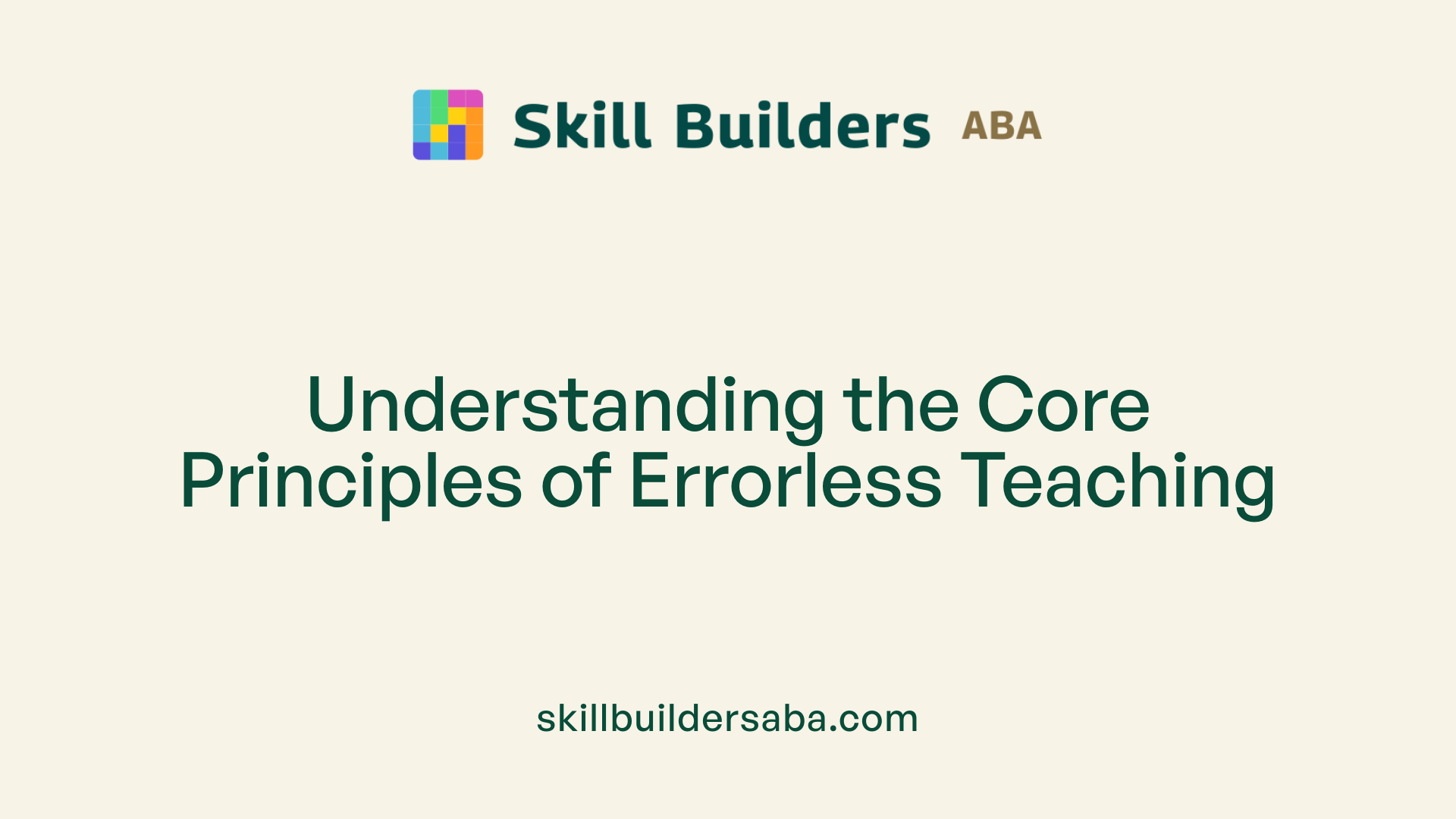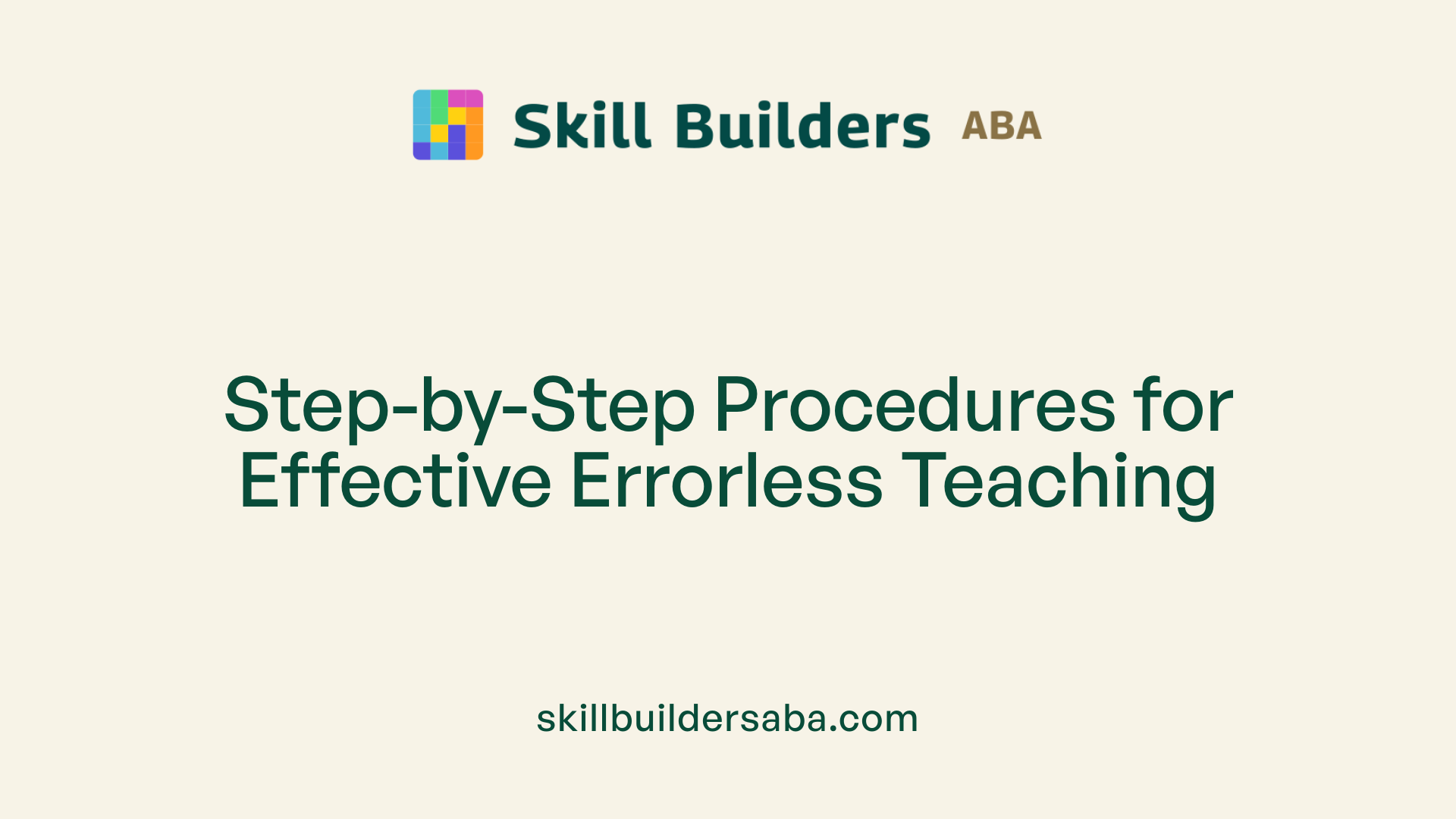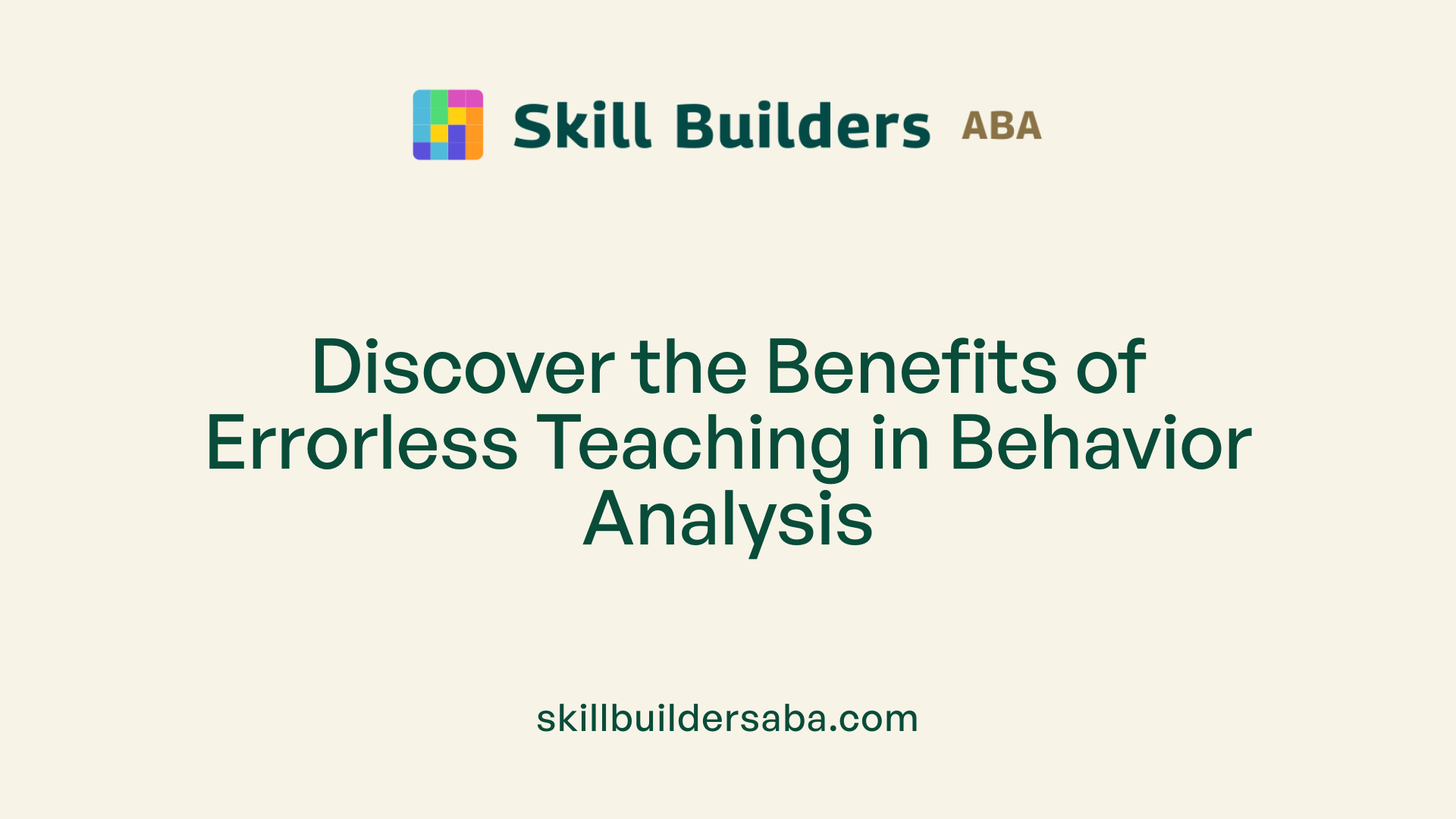
Understanding errorless teaching in ABA
Harnessing the Power of Errorless Learning in ABA Therapy
Introduction to Errorless Teaching in Applied Behavior Analysis
Errorless teaching is an innovative instructional approach within Applied Behavior Analysis (ABA) designed to optimize learning by preventing mistakes during skill acquisition. This method emphasizes the importance of providing consistent prompts, cues, or assistance immediately following instructions to guarantee correct responses from learners, thereby fostering confidence and reducing frustration. As a scientifically supported technique, errorless teaching employs a structured framework that systematically fades prompts over time, promoting independence and positive outcomes for individuals with developmental challenges, especially autism spectrum disorder.
Fundamentals of Errorless Teaching in ABA

What is errorless teaching in Applied Behavior Analysis (ABA)?
Errorless teaching is an instructional approach widely used in ABA that emphasizes preventing errors during skill acquisition. It involves providing prompts immediately after an instruction to guide learners toward the correct response, ensuring they do not make mistakes during learning sessions. Over time, prompts are systematically reduced or faded, promoting independence in performing skills.
This method uses a hierarchy of prompts — including physical, verbal, and visual cues — to support learners at different levels of assistance. By minimizing errors, errorless teaching reduces frustration and problem behaviors often linked to mistakes, creating a positive learning environment.
Key strategies in its implementation include prompt fading techniques like least-to-most prompting or time delay methods. These strategies gradually shift independence toward the learner. The overall goal is to encourage correct responses from the start and reinforce these to build confidence and mastery.
Errorless teaching is particularly effective for individuals with learning challenges, cognitive difficulties, or those who tend to develop routines quickly. It aligns with ABA’s evidence-based practices, providing a scientifically supported way to help learners acquire various skills—from daily living tasks to academic skills and communication.
Principles of errorless teaching
The core principles involve careful planning and execution. First, a clear goal is set, then broken into teachable components. Prompts are selected based on the learner’s current abilities and the need for support.
During each trial, prompts are used to guide correct responses. If errors occur, the teacher repeats the trial with more support or a different prompt, rather than allowing errors to reinforce incorrect responses. As learners succeed reliably, prompts are systematically faded using techniques like most-to-least prompting or timed delays.
The method relies on immediate reinforcement of correct responses to strengthen learning. Each session includes practice, reward, and prompt fading to promote skill generalization and independence over time.
Role of prompts and reinforcement
Prompts are crucial in errorless teaching as they guide the learner toward the correct response. They can vary from full physical guidance to simple visual cues, depending on what’s most effective for the learner.
Positive reinforcement accompanies each correct response, reinforcing the learner's success and encouraging continued effort. Reinforcers are tailored to the individual, ensuring they are motivating and meaningful.
Prompt fading is essential to prevent dependency. Techniques such as most-to-least prompting or time delay help gradually reduce prompts while maintaining correct responding. The combination of prompts, reinforcement, and systematic fading creates an effective learning process that maximizes independence and skill retention.
Methodology and Procedures of Errorless Teaching

What techniques and procedures are involved in errorless teaching?
Errorless teaching is an instructional approach that employs structured prompting techniques to ensure learners respond correctly during learning sessions, minimizing errors and frustration. This method is grounded in the belief that children, especially those with autism or communication challenges, learn more effectively when mistakes are prevented.
The process begins with selecting a clear learning goal and breaking it into manageable components. An appropriate prompt level—ranging from physical and verbal to visual—is chosen based on the learner's current abilities. The instructor then provides immediate prompts following the instruction, guiding the learner toward the correct response.
Throughout the teaching process, various prompting and reinforcement strategies are used, including modeling, physical assistance, or visual cues. These prompts are systematically faded using specific fading techniques such as least-to-most prompting, most-to-least prompting, or time delay procedures. The goal of prompt fading is to gradually reduce assistance, encouraging independent responses.
This method also involves ongoing monitoring to determine when the learner can perform the skill independently, and adjustments are made as necessary. Positive reinforcement is provided for correct responses, reinforcing learning and building confidence.
Overall, errorless teaching combines early and systematic prompting with reinforcement and prompt fading, creating an environment where errors are prevented, and learning is optimized.
Step-by-step process
- Identify the skill and mastery criteria: Establish specific, measurable goals.
- Select the prompt level: Choose the least intrusive prompt that still ensures success.
- Begin teaching trials: Present the instruction and immediately prompt the response.
- Reinforce correct responses: Use positive reinforcement consistently.
- Fade prompts systematically: Gradually reduce prompts using strategies like time delay or prompt hierarchy.
- Assess independence: Use check trials to confirm mastery and independence.
- Generalize and monitor: Practice across different settings and continue to assess progress.
Prompt hierarchy and fading strategies
Errorless teaching employs a hierarchy of prompts to support learners, starting with physical prompts, then verbal, and visual prompts as needed. The prompts are faded using various methods:
| Strategy | Description | Example |
|---|---|---|
| Least to Most Prompt | Begin with the least intrusive prompt and increase if needed | Visual pairings followed by physical prompts |
| Most to Least Prompt | Start with the most intrusive prompt, then fade away | Physical prompts to visual cues |
| Time Delay | Introduce a pause before prompting to encourage independent response | Wait 3 seconds before prompting |
| Graduated Guidance | Use a series of prompts of increasing assistance | Hand-over-hand correction |
Error correction procedures
When an error occurs during teaching, the procedure involves immediately ending the current trial and returning to a more intrusive prompt or the initial prompt level. This ensures the learner doesn't practice an incorrect response. Following the error, the instructor can repeat the trial, providing prompts again and reinforcing the correct response.
Reinforcement continues for correct answers, and prompt fading proceeds as the learner demonstrates mastery. The overall focus remains on preventing errors, reinforcing correct responding, and promoting independence through systematic prompt reduction.
Advantages and Benefits of Errorless Teaching

How does errorless teaching reduce errors and frustration?
Errorless teaching is designed to minimize mistakes during the learning process by providing immediate prompts that guide the learner toward the correct response. This proactive approach prevents the occurrence of incorrect answers and the frustration often associated with trial-and-error learning. When errors are avoided, learners are less likely to become discouraged or experience anxiety, creating a more positive and stress-free environment conducive to learning.
The use of systematically fading prompts further ensures that the learner gradually relies less on assistance, promoting independence. Prompt fading techniques, such as most-to-least prompting or time delay strategies, are employed throughout the instruction to gently shift responsibility to the learner without the risk of errors.
How does errorless teaching build confidence and independence?
By consistently guiding learners toward correct responses, errorless teaching fosters a sense of achievement. Success in each trial boosts learners’ confidence, encouraging them to participate actively and take initiative in their learning. As prompts are faded systematically, learners begin to perform skills independently, building their confidence in their abilities.
This approach is especially beneficial for individuals who may become prompt-dependent or struggle with traditional trial-and-error methods. The positive reinforcement following correct responses further enhances motivation and fosters a sense of competence.
How does errorless teaching contribute to decreasing maladaptive behaviors?
Errors often provoke negative behaviors such as tantrums, aggression, or self-injury, especially in children with autism or communication challenges. By preventing errors, errorless teaching reduces the likelihood of these maladaptive responses.
The structured environment of errorless learning ensures that learners experience successful interactions, decreasing frustration and behavioral issues. This method promotes a more positive learning experience, reducing the triggers for problem behaviors and supporting smoother, more adaptive development.
Overall, errorless teaching offers a comprehensive approach that not only accelerates skill acquisition but also supports emotional well-being by minimizing stress and frustration.
| Aspect | Impact | Additional Details |
|---|---|---|
| Reduction of errors | Prevents incorrect responses | Immediately prompts correct response, systematic fading of prompts |
| Fostering confidence | Builds learner motivation | Success boosts independence and self-esteem |
| Decrease of maladaptive behaviors | Lowers frustration-triggered behaviors | Affects problematic behaviors like aggression and tantrums positively |
This approach benefits learners needing extra support, especially those with autism or cognitive difficulties, by creating an encouraging and effective learning environment.
Application and Practical Implementation in ABA Therapy

How is errorless teaching applied in ABA therapy?
Errorless teaching is a widely used approach within ABA therapy, designed to help learners acquire new skills efficiently while minimizing mistakes and frustration. The process begins with careful planning, where therapists identify the specific skill to be taught and break it down into smaller, teachable components using a method called task analysis.
Once the skill is broken down, the therapist selects an appropriate prompt hierarchy. Prompts can include physical guidance, verbal cues, visual supports, gestural prompts, or modeling. Starting with the least invasive prompt that still guarantees a correct response, the therapist provides immediate assistance to the learner. This immediate prompt prevents errors from occurring during the learning trial.
As the learner begins to master the task, prompts are systematically faded using strategies such as most-to-least prompting, where therapists reduce the prompt level gradually; time delay prompting, where the wait time before prompt increases; or stimulus fading, where prompts are gradually removed while maintaining the visual or physical cues.
Positive reinforcement plays a crucial role, as correct responses are immediately rewarded, encouraging repeated successful behavior. The repeated practice and reinforcement help build confidence and foster independence.
Practitioners continuously monitor progress, adjusting prompts and fading methods to match the learner’s development. The goal is to create a positive learning environment that reduces errors, increases motivation, and promotes skill mastery.
Overall, applying errorless teaching in ABA requires a structured, individualized, and adaptable approach, emphasizing careful planning, prompt hierarchy management, and ongoing evaluation to support effective learning and skill acquisition.
Research and Evidence Supporting Errorless Teaching

What is the evidence supporting the effectiveness of errorless teaching in ABA?
Several empirical studies affirm that errorless teaching is highly effective for skill acquisition, especially for individuals with developmental disabilities, including autism. Randomized controlled trials and clinical research have consistently shown that this method helps learners respond correctly and confidently, often more quickly than traditional errorful methods.
Research indicates that errorless learning reduces problematic behaviors such as frustration, tantrums, and aggression that can occur due to mistakes during learning. By providing immediate prompts and systematically fading them over time, learners are more likely to succeed and develop independence.
Funding from organizations like the National Institutes of Health (NIH) supports the scientific validity of errorless teaching within ABA. These studies show that with fidelity, errorless methods improve discrimination skills, promote positive behaviors, and decrease maladaptive responses.
In summary, the body of research underscores errorless teaching as not only effective but also a reliable approach for diverse educational and behavioral goals.
Summary and Final Thoughts
Errorless teaching in ABA stands as a robust, empirically supported instructional strategy that significantly enhances skill acquisition processes for individuals with developmental disabilities. By systematically preventing errors, fostering confidence, and reducing frustration, it creates an optimal learning environment tailored to the needs of learners who benefit most from structured, cue-based interventions. While it demands careful prompt management and ongoing adjustments, its benefits—faster learning, fewer maladaptive behaviors, and increased independence—make it a vital component of effective ABA practice. As research continues to validate its efficacy, errorless teaching remains a cornerstone technique for practitioners aiming to deliver high-quality, evidence-based education.
References
- Errorless Learning: Complete Guide - Master ABA
- [PDF] Errorless Teaching.pdf
- Errorless Teaching - Florida Atlantic University
- Errorless Learning in ABA Therapy: The Ultimate Guide
- Episode 111: Errorless Teaching - How to ABA
- Errorless Learning In ABA Therapy | Circle Care Services
- Errorless Learning: Complete Guide - Master ABA
Reach Out Today
Learn more about how we can support your child’s growth and development. Contact us to discuss our services and availability in your area.
.svg)